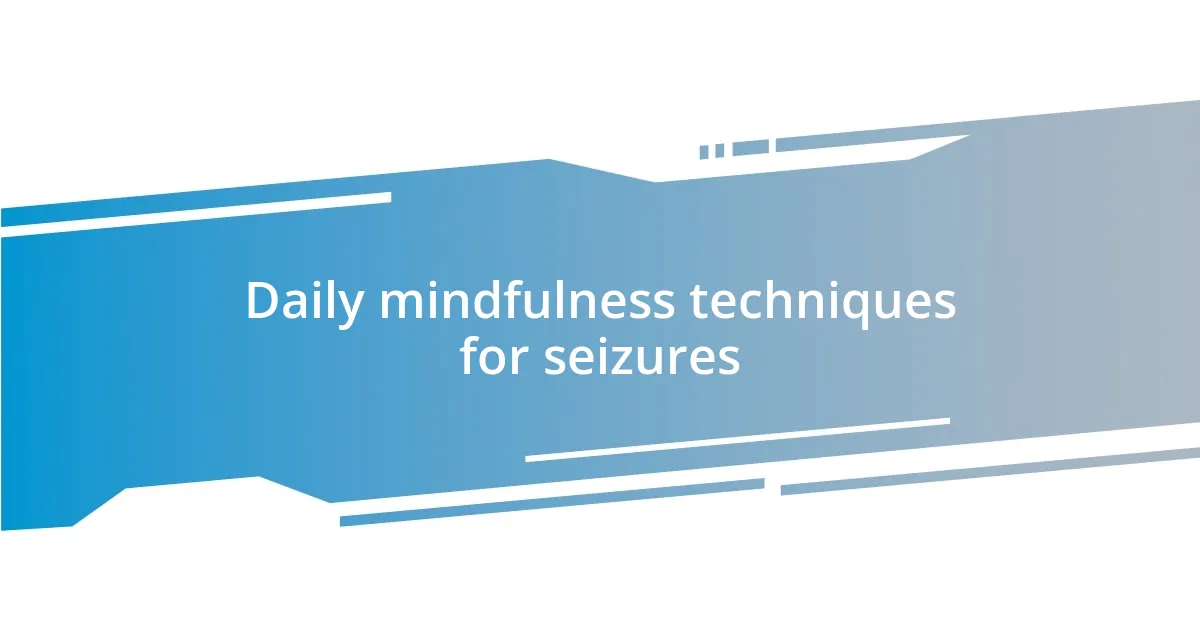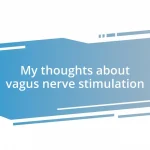Key takeaways:
- Epilepsy involves unpredictable seizures, varying in type and intensity, and understanding these variations is crucial for coping.
- Mindfulness practices, such as meditation, breathing exercises, and gratitude journaling, significantly enhance emotional balance and stress management for individuals with epilepsy.
- Journaling helps identify personal seizure triggers and emotional patterns, providing therapeutic benefits and deeper self-understanding.
- Creating a calming mindfulness environment and sharing practices with supportive individuals can amplify the effectiveness of mindfulness routines.

Understanding epilepsy and seizures
Epilepsy is a neurological condition characterized by recurrent seizures, which are sudden bursts of electrical activity in the brain. I remember the first time I witnessed someone have a seizure; it was both shocking and alarming. My heart raced as I realized how unpredictable and disorienting these episodes could be, not just for the person affected, but for everyone around them.
Seizures can vary widely in their presentation. Some are brief episodes of staring, while others cause uncontrollable shaking. It makes me wonder: how do people cope with such a lack of control? In my experience, understanding the different types of seizures is crucial. It’s essential to recognize that each seizure is unique and can affect individuals remarkably differently.
Living with epilepsy also means grappling with the stigma and fear that often accompany it. People may not understand what they are witnessing during a seizure, leading to confusion or shame for the person experiencing it. I’ve seen how empowering education can be, not just for those affected, but for friends and family who want to provide support. How can we foster better understanding and compassion in our communities?

The role of mindfulness practices
In my journey with epilepsy, I’ve found that incorporating mindfulness practices has made a remarkable difference in my overall well-being. Mindfulness helps me anchor my thoughts and emotions, especially during those uncertain moments before a seizure. By focusing on the present, I can cultivate a sense of calm and reduce the anxiety that can accompany the unpredictability of seizures. This shift in mindset has been empowering; I feel more equipped to manage stress and maintain emotional balance.
Here are some specific mindfulness practices that I’ve integrated into my routine:
- Meditation: I often spend just a few minutes each day meditating, which helps clear my mind and center my thoughts.
- Breathing exercises: Focusing on my breath can really ground me, especially when I feel anxiety creeping in.
- Body scans: I practice body awareness, tuning in to how my body feels, which helps me respond to tension before it escalates.
- Mindful movement: Whether it’s gentle yoga or walking in nature, being aware of my body in motion creates a connection that fosters serenity.
- Gratitude journaling: I take a moment each day to jot down what I’m grateful for, reinforcing positive emotions and shifting my focus from fear to appreciation.
These practices have not only aided in seizure management but have also nurtured a deeper understanding of myself and my experiences. Embracing mindfulness has transformed my relationship with epilepsy, allowing me to navigate each day with increased resilience and hope.

Daily mindfulness techniques for seizures
Incorporating daily mindfulness techniques has been a game-changer for my seizure management. One technique I particularly cherish is my morning meditation ritual. No matter how hectic the day ahead seems, starting with just ten minutes of quiet reflection centers me. I remember a particularly tough day when anxiety threatened to overwhelm me; taking that time to breathe deeply helped ground me, and I entered the day feeling more robust and less susceptible to stress.
Breathing exercises also play a vital role in my daily routine. Whenever I sense tension building up, I intentionally pause to focus on my breath. I picture each inhale as a wave of calm washing over me while the exhale releases any anxiety. I’ve found that even in public spaces, a few mindful breaths can help me reclaim my inner peace. It’s as if I carry this tool that no one else can see, but it empowers me to face challenges head-on.
Lastly, I’ve embraced gratitude journaling, and it’s incredible how this simple act shifts my perspective. Each evening, I jot down three things I’m grateful for, regardless of how small they may seem. On particularly tough days, it can be the slightest joy, like a warm cup of tea or the comfort of my favorite cozy blanket. This practice not only reshapes my focus but also reminds me that even when life feels challenging, there’s always some light to be found. These routines might seem simple, but they weave a profound sense of resilience into the fabric of my daily life.
| Mindfulness Technique | Description |
|---|---|
| Meditation | Quiet reflection each morning sets a calm tone for the day. |
| Breathing Exercises | Focused breathing helps me release tension and anxiety in real-time. |
| Gratitude Journaling | Writing down things I’m grateful for shifts my focus from fear to appreciation. |

Mindful breathing exercises for calm
Mindful breathing exercises have become a cornerstone of my daily routine. One memorable moment was during a particularly stressful social gathering. As I felt my heart race, I found a quiet corner, closed my eyes, and took a series of slow, deep breaths. With each inhale, I visualized the tension melting away, and I distinctly remember the wave of calm washing over me. It was a simple act, but it reminded me how powerful breathing can be when faced with anxiety.
In practice, I often use a technique called “4-7-8 breathing.” Inhale for a count of four, hold for seven, and exhale slowly to a count of eight. This rhythm feels like a soothing mantra to my overwhelmed mind. I often wonder if others realize how effective such a simple practice can be in those moments where everything feels chaotic. Just recently, I tried this method while waiting for a medical appointment that always sets my nerves on edge; by the time my name was called, I felt grounded and ready to face whatever challenges lay ahead.
What truly amazes me is how transformative these breathing exercises can be over time. When practiced consistently, they create a reservoir of calm that I can draw upon during the stormy moments. It’s like having an internal toolbox, filled with techniques I can deploy whenever that familiar anxiety nudges at my peace. I regularly remind myself that cultivating this awareness isn’t just about managing seizures; it’s about nurturing an overall sense of well-being that influences every aspect of my life.

Journaling experiences and triggers
Keeping a journal has been an eye-opening experience for me—especially when it comes to tracking my seizure triggers. I still remember the day I first started recognizing patterns in my entries. By noting my physical and emotional states, I quickly noticed that certain stressors, like late nights or intense conversations, often coincided with my seizures. Has anyone else felt like they were missing pieces to their own puzzle? I know I did until journaling made those connections crystal clear.
I also discovered that reflecting on my feelings before and after a seizure can help reveal emotional triggers I hadn’t considered. One particular entry struck me; I had written about a day filled with anxiety and tension, and soon after, experienced a seizure. That realization hit home. By revisiting those moments, I could address underlying emotions rather than just the physical symptoms. It makes me wonder—what if journaling could unearth deeper insights for others too?
As I fill the pages, it’s not just about documenting data; it feels deeply therapeutic. There’s something cathartic about putting pen to paper and processing what I’m feeling in real time. I recall one evening when I poured out my frustration after a day full of challenges. The act of writing shifted that pent-up energy into clarity and helped me pave the way for a calmer tomorrow. Have you ever felt the weight of the world lift after expressing your thoughts? I find it freeing. This simple act of journaling isn’t just a tool; it’s a journey toward understanding my response to life’s ups and downs.

Creating a supportive mindfulness environment
Creating a supportive mindfulness environment starts with cultivating a space that resonates with calm. I’ve found that when I designate a corner of my home solely for mindfulness practices, it transforms into a sanctuary. Whether it’s a cozy chair, soft lighting, or a few cherished plants, having this dedicated space signals my mind that it’s time to slow down. Have you ever noticed how certain places just feel right for relaxation?
The sounds around us also play a crucial role in this experience. I often use calming music or nature sounds while I meditate. One time, I was struggling to focus, so I tried playing soft rain sounds in the background. It was like a warm blanket that enveloped me, instantly grounding me in the moment. I felt less distracted, as if the world around me faded into a gentle hum, allowing my thoughts to settle.
Lastly, I believe sharing my mindfulness space with supportive friends or family can amplify its benefits. One afternoon, I invited a close friend over for a mindful tea session. We sat in silence, sipping herbal tea and enjoying the serenity together. I still remember how comforting it was, knowing we were both intentionally creating a calm atmosphere. It made me wonder—how often do we allow others to join us in our journeys towards peace? Inviting someone into your mindful practices not only strengthens your bonds but also enhances the positivity in that space.

Resources for ongoing mindfulness practice
To sustain an ongoing mindfulness practice, I’ve found a variety of resources invaluable. Online platforms like Headspace and Insight Timer offer guided meditations that cater to different needs and levels. For me, discovering a meditation specifically tailored for seizure management was a game changer. Have you ever stumbled upon a resource that resonated so deeply with you that it felt like it was made just for you? That’s how I felt when I first tried a meditation focused on anxiety reduction.
Books about mindfulness can also provide rich insights and practical exercises. I remember reading “The Miracle of Mindfulness” by Thich Nhat Hanh, which introduced me to the concept of mindful breathing. It was profound how something so simple could anchor my thoughts and reduce my stress levels. Have you ever paid attention to your breath in a challenging moment? I started practicing this technique whenever I felt the onset of anxiety, and it transformed those moments from overwhelming to manageable.
Finally, attending local mindfulness workshops or classes has been a huge boon. Engaging with others who share similar experiences fosters a sense of community that further supports my journey. I vividly recall attending a weekend retreat where we practiced mindfulness together; the collective energy uplifted my own practice. Have you thought about how shared experiences can deepen our understanding? Connecting with others in these settings makes mindfulness feel less like a solo endeavor and more like a shared path to peace.













